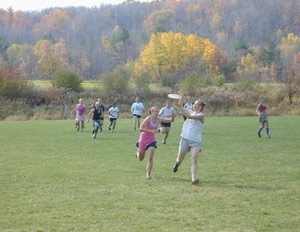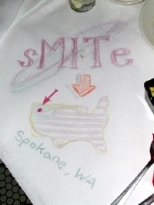Thirteen MIT undergraduates and graduate students, five of whom never played the sport before last fall, reeled off 26 consecutive ultimate Frisbee victories before losing to the eventual winner in the National Women's Championships in Spokane, Wash., on Memorial Day weekend.
The 15-9 semifinal loss to the University of California at San Diego did not put a damper on a fantastic season for the MIT club, which wound up with a 29-5 record, beating Harvard, Princeton, Yale, Cornell, Brown, Williams, Tufts, Stanford, Texas, Oregon and Virginia. MIT tied with Colorado for third in the nationals.
After the team won the eastern regional tournament May 4-5 at Dartmouth to earn a spot in the nationals, the players celebrated at a restaurant which happened to have crayons and paper towels for placemats. Using the crayons, Kathleen Dobson, a junior in mechanical engineering, drew an outline of the United States, pinpointing Spokane, and wrote: "sMITe." It became a mission.
"I've never been on a team that is so sure of themselves, even when they are down," said April Rasala of Newton, who played soccer at Dartmouth as an undergraduate and was introduced to ultimate Frisbee by former MIT captain Jessica Young (Ph.D. 2001).
Rasala worked up the nerve to go out for the team during her second year as an MIT graduate student in computer science. "I went out to the first practice and found out that almost everyone starts from scratch," she said. "The team is really good about teaching the game and being patient."
Only one member of the team, co-captain Nancy Sun, a sophomore from Princeton Junction, N.J., played organized ultimate Frisbee in high school. The others played a variety of varsity sports, including basketball, soccer, track, tennis and field hockey.
"This is part of why we were so successful, even though this was the first year of playing for many of us," said Dobson, a volleyball and basketball player from Rhinebeck, N.Y. "We are a very athletic team and many people use skills they learned in other sports and apply them to ultimate, like the soccer people know how to cut and the basketball players know how to box out and grab the disc."
The highlight of the season was a 15-9 victory over Stanford in the nationals. The most memorable play: Dobson, covered by Stanford's best defender, scored a goal by throwing the disc to the exact spot the opponent was defending. The tactic is called "breaking the mark." It may have broken Stanford's spirit.
The team also rallied from a 6-2 deficit to beat Oregon, 15-10.
"Many teams would crumble," said Rasala, who is a receiver. "Instead, we all looked at each other and said we knew we could win. We calmed down, played our game and pulled it out. I was really proud of our coaches and the leaders on the team for remaining so calm."
The team practiced twice a week, starting indoors during the winter and moving outdoors after the season started in March. The coaches--James Sarvis, a graduate student in electrical engineering and computer science, and alumnus Stacy McGeever (S.B. 1994)--patiently developed the players' knowledge of the game and their skills. They also instilled a love for the game in the players.
"It's really a fun sport because it requires a lot of athleticism and strategy," said Rasala. "Also, unlike other sports, there is a built-in concept called 'spirit of the game,' which is essentially good sportsmanship. This spirit is actively fostered by the Frisbee community. Many times, even in competitive games, if someone makes a great play, players on both teams will congratulate them. It lends a nice feeling to the games even if you don't win."
PLAYING THE GAME
Ultimate Frisbee is played seven to a side on a 70-by-40-foot field with 25-foot end zones. The teams start out standing in facing end zones. Handlers control the disc and throw it to receivers cutting and racing down field. On defense, players try to intercept the disc, disrupt it in midair (called a D), or get a block. A goal counts for one point.
A handler starts play by throwing the disc (called pulling) to the opposing team. The team that receives the disc is on offense until it scores a goal or drops the disc, or the opponent intercepts a pass. The offensive team members move the disc by throwing it to each other. A team scores by catching it in the opposing end zone. After a score, the team remains in that end while the other team shifts to the opposite end zone to receive. Substitutions are allowed after a goal.
The first team to score 15 with a two-point margin is a winner at the national championships. In some instances, a time limit is imposed to end a prolonged match.
A version of this article appeared in MIT Tech Talk on June 5, 2002.







